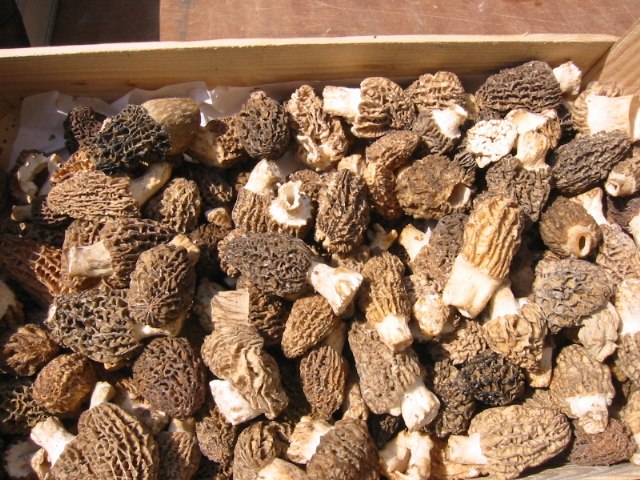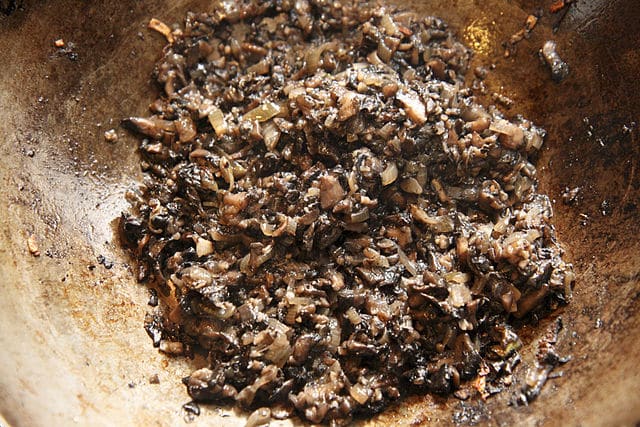
The downside is that when you get all these mushrooms home, you realize that you’re simply not going to be able to eat all of them before they go bad. Maybe your friends and family are a little weirded out by the idea of eating mushrooms that didn’t come packaged in styrofoam at the grocery store, so giving the mushrooms to them won’t work. Or you might not be interested in selling the extras for some cash. So what do you do with them?
Thankfully there are options for long-term preservation for most edible wild mushrooms. Not every method will work for every species, so it’s important to research which methods work best for the ones you have an overabundance of.
Dehydrating Wild Mushrooms
The two main methods of preservation are dehydration and freezing. Let’s start with dehydration. The easiest way is to use a food dehydrator. They are specifically designed so that dehydration is done evenly, and many dehydrators allow you to stack several layers of mushrooms (or other food) for better efficiency. If you do not have a dehydrator, you can also use a regular oven or a toaster oven. Some people even hang mushrooms in a greenhouse or other warm, sunny location and let the sun dry them, though this usually takes longer than a dehydrator or oven. If there’s no wind, a fan can help facilitate drying.
Most mushrooms will need to be cut into thin slices rather than dehydrated whole. However, mushrooms that are hollow inside, such as morels, can be dehydrated whole as the hollow center allows for more even dehydration.

To dehydrate mushrooms in a dehydrator or oven, make sure your mushrooms are not wet (such as from rain or being washed). Then lay them out on the dehydrator screen or a baking sheet in a single layer, with a little space around each one so that they are not touching. Dry them at a low heat, around 140 to 150 degrees F. The exact time will vary depending on the size and thickness of the mushrooms, so check them every half hour or so. You want them to be dried to cracker dryness, so they snap rather than squish or bend when bent.
Dehydrating Without Electricity
To dry mushrooms in the sun, you can either lay them on a screen or sheet, or use a needle to string them on a strong thread, then hang them up, making sure there’s a little space in between the mushrooms so they have good air flow. It can take a day or two if it’s warm, a little longer if temperatures are cool. You want to make sure they are completely dry, as any moisture can make them moldy.
Freezing Wild Mushrooms
Some mushrooms do better when frozen; for example, the flavor and texture of chanterelles and boletes often holds up better with freezing than drying. But you can’t just stick them right in the freezer. Instead, they need to be cooked first, then frozen in air-tight containers such as vacuum sealed bags or freezer bags.

Most wild mushrooms can be sauteed in an oil like olive oil or butter. Slice or chop the mushrooms, then add to a pan at medium-high heat with just enough oil to keep them from sticking. Sautee until cooked through, constantly stirring them to keep them moving and cook them evenly, then remove from heat, cool, and freeze.
Delicate mushrooms like shaggy manes can be blanched in boiling water for a minute, then dabbed dry and frozen. Very moist mushrooms like chanterelles may be dry-sauteed. Heat a pan over medium-high heat, and add a pinch of salt to the pan. Add the mushrooms (do NOT add butter or oil), and then sautee them in the salt, moving them constantly. The mushrooms should release their internal moisture; keep sauteeing until that moisture cooks off or is reabsorbed. Then remove from heat, cool, and freeze.
Canning Wild Mushrooms
Wild mushrooms can be canned if properly cooked; however, the chance of contamination is higher than with the other methods as home canning can be a tricky process. Your best bet is to follow the instructions in the manual that comes with your home canner, or to study the instructions in books and websites about canning. Some may have instructions specifically for mushrooms. Using a pressure canner is a safer, more reliable method than the boiling water bath method.
Storing Preserved Mushrooms
How long will preserved mushrooms last? Dried mushrooms, kept in airtight containers in a cool, dry place, can last a year or more. Some people claim they last “indefinitely”, but you should check them periodically for decay, mold, or other damage. The longer you let them sit, the more likely that they will lose flavor or texture, or become unsafe. Dried mushrooms can be stored in a jar, canister, or other air-tight container. If you wish, you can also powder them before storage; a coffee grinder used only for mushroom works well. To rehydrate dried mushrooms, soak them in water for 15-30 minutes; take them out of the water as soon as they are rehydrated so that flavor doesn’t leach out. If you’re making a soup or other wet food you can use the soaking water in it.
Mushrooms can be stored in the freezer for up to a year, but again the longer they sit there the more the flavor and texture may degrade. Always make sure you cook thawed mushrooms immediately, and never re-freeze them.
—————
Written by Rebecca Lexa
Rebecca Lexa is a certified Master Naturalist in the Pacific Northwest. She teaches classes on foraging and other natural history topics, both online and off. More about her work can be found at http://www.rebeccalexa.com.
Many of our readers find that subscribing to Eat The Planet is the best way to make sure they don't miss any of our valuable information about wild edibles.
See our privacy policy for more information about ads on this site







One Response
My name is Bob Berrigan. My telephone is 916-204-5258. My favorite pastime is gardening. I would love to make contact with female persons with same interest!